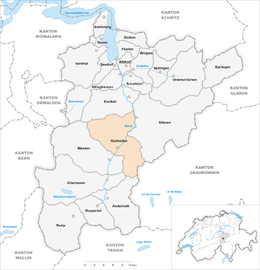Gurtnellen
| Gurtnellen | ||
|---|---|---|
 |
||
|
||
| Coordinates: 46°43′N 8°37′E / 46.717°N 8.617°ECoordinates: 46°43′N 8°37′E / 46.717°N 8.617°E | ||
| Country | Switzerland | |
| Canton | Uri | |
| District | n.a. | |
| Area | ||
| • Total | 83.35 km2 (32.18 sq mi) | |
| Elevation | 928 m (3,045 ft) | |
| Population (Dec 2015) | ||
| • Total | 577 | |
| • Density | 6.9/km2 (18/sq mi) | |
| Postal code | 6482 | |
| SFOS number | 1209 | |
| Surrounded by | Andermatt, Erstfeld, Göschenen, Silenen, Tujetsch (GR), Wassen | |
| Website |
www SFSO statistics |
|
Gurtnellen is a village and a municipality in the canton of Uri in Switzerland.
Gurtnellen is first mentioned in 1257 as Chuno und die Gurteneller. In 1321 it was mentioned as Gruntellon, and in 1359 as Gurtenellen.
Gurtnellen has an area, as of 2006[update], of 83.4 km2 (32.2 sq mi). Of this area, 11.9% is used for agricultural purposes, while 25.1% is forested. Of the rest of the land, 1.3% is settled (buildings or roads) and the remainder (61.7%) is non-productive (rivers, glaciers or mountains). In the 1993/97 land survey[update], 16.9% of the total land area was heavily forested, while 5.2% is covered in small trees and shrubbery. Of the agricultural land, 0.0% is used for farming or pastures, while 2.9% is used for orchards or vine crops and 9.0% is used for alpine pastures. Of the settled areas, 0.2% is covered with buildings, 0.1% is industrial, 0.2% is classed as special developments, and 0.8% is transportation infrastructure. Of the unproductive areas, 0.1% is unproductive standing water (ponds or lakes), 0.9% is unproductive flowing water (rivers), 39.3% is too rocky for vegetation, and 21.4% is other unproductive land.
The municipality is located above the Reuss along the Gotthard rail line. It consists of the village sections of Dorf, Wiler, Intschi, Arni as well as part of the area on the left side of the Reuss near Amsteg and Silenen.
Gurtnellen has a population (as of 31 December 2015) of 577. As of 2007[update], 4.4% of the population was made up of foreign nationals. Over the last 10 years the population has decreased at a rate of -8.7%. Most of the population (as of 2000[update]) speaks German (97.3%), with Portuguese being second most common ( 1.6%) and French being third ( 0.5%). As of 2007[update] the gender distribution of the population was 50.0% male and 50.0% female.
...
Wikipedia




